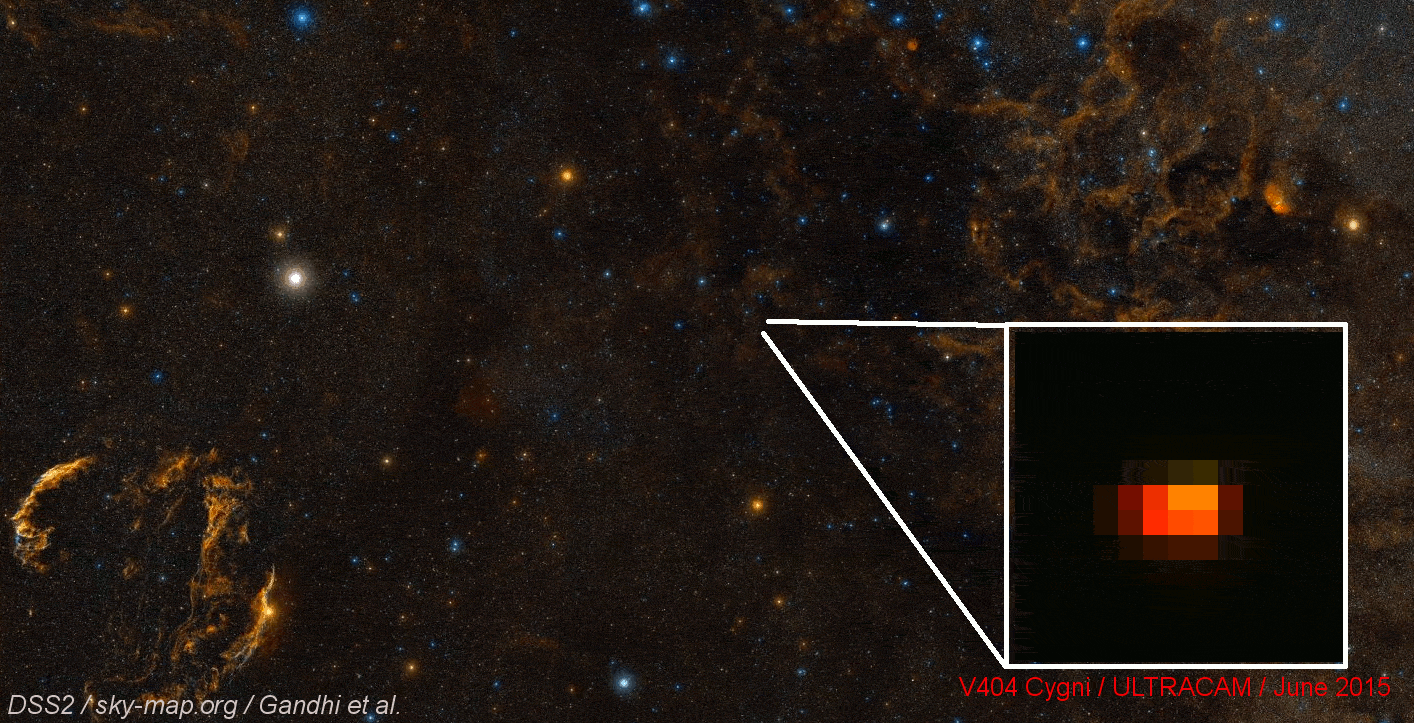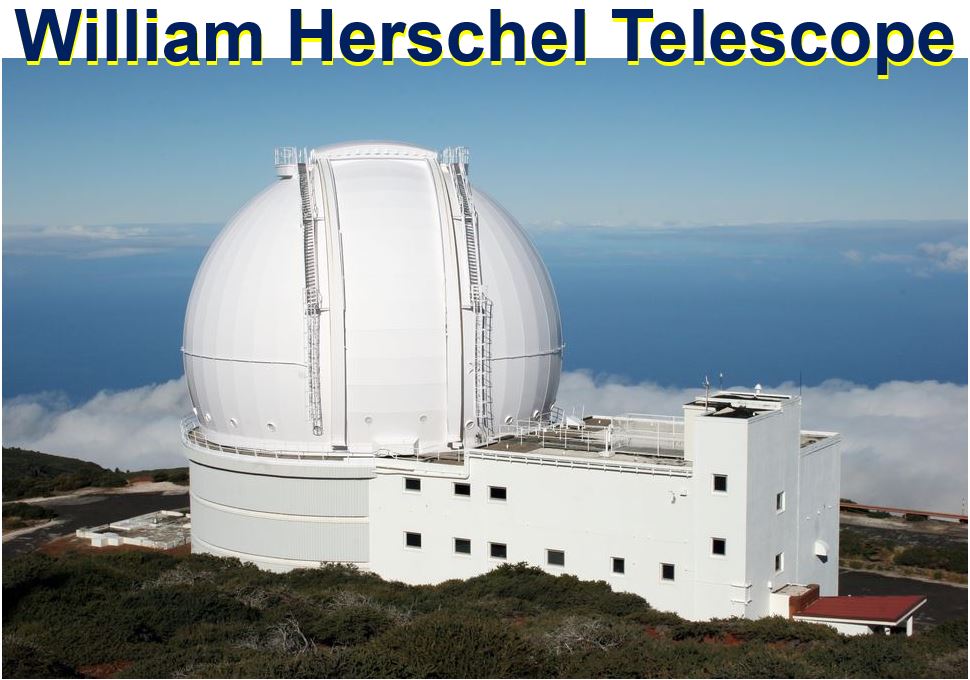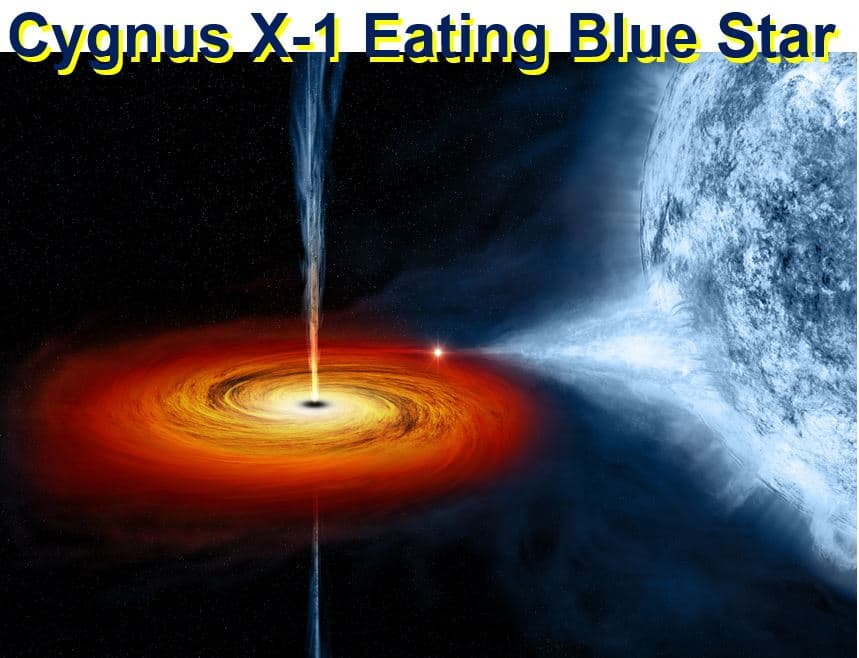A violent black hole has been observed devouring a companion star and emitting the energy to power 1000 of our Suns, says an international team of scientists. The black hole – called V404 Cygni – is about 7,800 light years from Earth.
V404 Cygni emitted intense red flashes which lasted a fraction of a second as it sucked in material from an orbiting companion star with its mega-gravity.
Scientists from the University of Southampton, who led this latest study, and colleagues from the UK, Spain, Italy, Germany, USA, Czech Republic, India, UAE and Germany, wrote about their findings in the scientific journal Monthly Notices of the Royal Astronomical Society (reference below).
 An artist’s depiction of the black hole V404 Cygni devouring material from a companion star. Jets of matter blasted out from close to the hole which created intensely-bright red flashes. (Image: ras.org.uk. Credit: L. Calcada/ESO/PA)
An artist’s depiction of the black hole V404 Cygni devouring material from a companion star. Jets of matter blasted out from close to the hole which created intensely-bright red flashes. (Image: ras.org.uk. Credit: L. Calcada/ESO/PA)
What they observed, they say, was the brightest black hole outburst in several years.
Bit off more than it could chew
V404 Cygni – the first definitive black hole to be identified in our galaxy (Milky Way) – became super-bright for approximately two weeks in June 2015. Sudden brightness commonly occurs when black holes gobble up material.
This black hole was devouring at such a rate that it blasted out material it could not swallow.
According to the scientists, the red colour was associated with fast-moving jets of matter that had been ejected very close to the black hole.
Their latest findings provide new insights into violent and extreme black hole phenomena, as well as how such jets are formed, the authors wrote.
 The black hole outburst was captured by the ULTRACAM, ultra-fast, triple-beam CCD camera, seen here being fitted onto the William Herschel Telescope. (Image: roe.ac.uk)
The black hole outburst was captured by the ULTRACAM, ultra-fast, triple-beam CCD camera, seen here being fitted onto the William Herschel Telescope. (Image: roe.ac.uk)
Lead author, Associate Professor Poshak Gandhi, STFC Ernest Rutherford Fellow in the University of Southampton’s Astronomy Group, said regarding where this red light came from:
“The very high speed tells us that the region where this red light is being emitted must be very compact. Piecing together clues about the colour, speed, and the power of these flashes, we conclude that this light is being emitted from the base of the black hole jet.”
“The origin of these jets is still unknown, although strong magnetic fields are suspected to play a role. Furthermore, these red flashes were found to be strongest at the peak of the black hole’s feeding frenzy.”
“We speculate that when the black hole was being rapidly force-fed by its companion orbiting star, it reacted violently by spewing out some of the material as a fast-moving jet. The duration of these flashing episodes could be related to the switching on and off of the jet, seen for the first time in detail.”
Scientists needed to react rapidly
These bright black hole outbursts are very unpredictable and extremely rare, the authors explained. This meant they had to react super-fast, otherwise they would lose an opportunity that might not present itself again for several years. V404 Cyngi’s last violent eruption was in 1989.
 Picture of a red flash captured from V404 Cygni by the ULTRACAM fast imager on June 26th, 2015. The fleeting flashes have the luminosity of around 1,000 times the Sun’s power. The Cygnus constellation (a region of the sky) can be seen in the background, with the Cygnus Loop supernova remnant on the left. (Image: ras.org.uk. Credit: DSS2/sky-map.org/Gandhi et al.)
Picture of a red flash captured from V404 Cygni by the ULTRACAM fast imager on June 26th, 2015. The fleeting flashes have the luminosity of around 1,000 times the Sun’s power. The Cygnus constellation (a region of the sky) can be seen in the background, with the Cygnus Loop supernova remnant on the left. (Image: ras.org.uk. Credit: DSS2/sky-map.org/Gandhi et al.)
In June 2015, V404 Cygni was incredibly bright, and provided a rare opportunity for such work. Studying black hole outbursts is usually extremely difficult because most of them are fairly dim.
Each flash was incredibly intense – with enough energy to power 1,000 of our Suns. They were also very short-lived, mostly lasting less than 1/40th of a second; about ten times the speed of the blink of an eye.
These amazing events can only be observed in a meaningful way with the latest technology. The scientists used the ULTRACAM, ultra-fast, triple-beam CCD camera, which was mounted on the William Herschel Telescope in La Palma on the Canary Islands.
Vik Dhillon, Professor of Astrophysics at the University of Sheffield’s Department of Physics & Astronomy, a co-creator of ULTRACAM, said regarding the super-sensitive camera:
“ULTRACAM is unique in that it can operate at very high speed, capturing high frame-rate ‘movies’ of astronomical targets, in three colours simultaneously. This allowed us to ascertain the red colour of these flashes of light from V404 Cygni”
 The ULTRACAM fast imaging camera is mounted on the William Herschel Telescope (above) in La Palma, on the Canary Islands. (Image: ing.iac.es)
The ULTRACAM fast imaging camera is mounted on the William Herschel Telescope (above) in La Palma, on the Canary Islands. (Image: ing.iac.es)
As a result of their study, findings and publication, the authors say astronomers across the world are now much keener to work together to observe future black hole outbursts.
Prof. Gandhi said regarding collaboration:
“Their short durations, and strong emissions across the entire electromagnetic spectrum, require close communication, sharing of data, and collaborative efforts amongst astronomers.”
“These observations can be a real challenge, especially when attempting simultaneous observations from ground-based telescopes and space satellites.”
What are black holes?
According to NASA, black holes are regions in space where gravity’s pulling force is so powerful that even light is not able to escape.
The mega-strong gravity occurs because matter has been squashed into a very tiny space. This compression may occur at the end of the life of a star. In fact, many black holes are the result of dying stars.
 An artist’s depiction of a black hole called Cygnus X-1. It formed when a huge star caved in. You can see it pulling matter from a blue star beside it. (Image: nasa.gov)
An artist’s depiction of a black hole called Cygnus X-1. It formed when a huge star caved in. You can see it pulling matter from a blue star beside it. (Image: nasa.gov)
Black holes are invisible – if no light comes from them, we cannot see them; we need light to see things. However, special space telescopes are able to find black holes by observing the behaviour of stars and material close to them.
There are three main types of black holes, which are differentiated by their mass and size:
– Primordial Black Holes: these are the smallest ones; they may be as tiny as a single atom, but have the mass of a large mountain.
– Stellar Mass Black Holes: these have a diameter of about 10 miles (16 km), but may have more than 20 times the mass of the Sun. The Milky Way is believed to have several Stellar Mass Black Holes.
– Supermassive Black Holes: these range in size from our Sun to a whole solar system, but have masses greater than one million Suns combined. Scientists say every large galaxy has a supermassive black hole at its centre.
The Milky Way’s supermassive black hole is called Sagittarius, which has a mass of about 4 million Suns. It’s diameter is about the same as our Sun’s.
Citation: “Furiously Fast and Red: Sub-second Optical Flaring in V404 Cyg during the 2015 Outburst Peak,” K. Mooley and T. Mu noz-Darias, P. Gandhi, D.J. Walton, S.P. Littlefair, L.K. Hardy, T. Shahbaz, C. Knigge, E. Kuulkers, D.M. Terndrup, J. Tomsick, V.S. Dhillon, T.R. Marsh, A.W. Shaw, D. Altamirano, M. Pahari, F. Rahoui, R.I. Hynes, M.D. Caballero-Garcia, J. Casares, D.M. Russell, J.V. Hernández Santisteban, Y. Dallilar, S. Eikenberry, R.P. Fender, P. Casella, A.J. Castro-Tirado & P.A. Charles. Monthly Notices of the Royal Astronomical Society. 14th March, 2016. DOI: 10.1093/mnras/stw571.
Video – V404 Cygni getting brighter
This Newcastle Observatory video is a compilaton of 716 CCD frames taken in Ic-band over three nights showing the black hole V404 Cygni brightening and then dimming.
